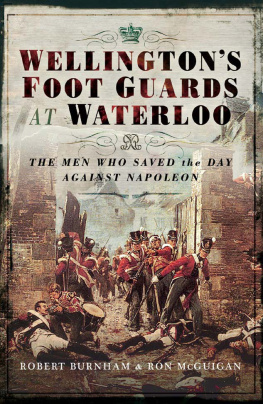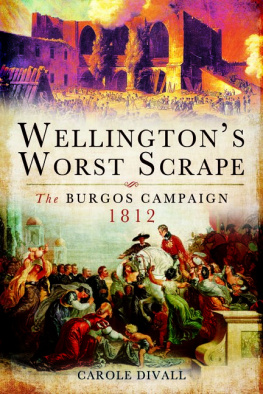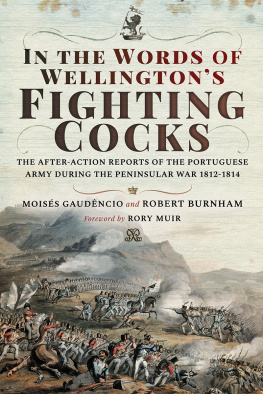Wellingtons Brigade Commanders
Wellingtons Brigade Commanders
Peninsula and Waterloo
Ron McGuigan and Robert Burnham
First published in Great Britain in 2017 by
Pen & Sword Military
an imprint of
Pen & Sword Books Ltd
47 Church Street
Barnsley
South Yorkshire
S70 2AS
Copyright Ron McGuigan and Robert Burnham 2017
ISBN 978 1 47385 079 8
eISBN 978 1 47385 080 4
Mobi ISBN 978 1 47385 081 1
The right of Ron McGuigan and Robert Burnham to be identified as the
Authors of this Work has been asserted by them in accordance with the
Copyright, Designs and Patents Act 1988.
A CIP catalogue record for this book is available from the British Library
All rights reserved. No part of this book may be reproduced or transmitted
in any form or by any means, electronic or mechanical including
photocopying, recording or by any information storage and retrieval system,
without permission from the Publisher in writing.
Pen & Sword Books Ltd incorporates the imprints of Pen & Sword
Archaeology, Atlas, Aviation, Battleground, Discovery, Family History,
History, Maritime, Military, Naval, Politics, Railways, Select, Transport,
True Crime, and Fiction, Frontline Books, Leo Cooper, Praetorian Press,
Seaforth Publishing and Wharncliffe.
For a complete list of Pen & Sword titles please contact
PEN & SWORD BOOKS LIMITED
47 Church Street, Barnsley, South Yorkshire, S70 2AS, England
E-mail:
Website: www.pen-and-sword.co.uk
Acknowledgements
This book could not have been written without the encouragement and generous assistance of a number of people.
A thank you to both Dr Rory Muir and Howie Muir for suggesting the idea for the book. Dr Muir kindly provided his research on filling in the blanks of the names suppressed in Wellingtons dispatches and correspondence as well as providing many of the unpublished letters of Henry Torrens, the Military Secretary to the Commander-in-Chief. Without this generous assistance, the book would be the poorer. A simple thank you is just not enough, Dr Muir. A further thank you to Howie Muir for providing a translation of a letter in French and also for readily answering any questions on different subjects concerning the generals, especially checking General Orders. We must also thank several individuals who were so helpful in our research, including Michael-Andreas Tnzer, the Director of the Arbeitskreis Hannoversche Militrgeschichte, who was a fount of knowledge on the Kings German Legion; Gareth Glover, the foremost expert on British memoirs; Mark Thompson for information on General Robert Long; John Gill for helping locate and translate obscure German regimental histories; Andrew Bamford for his help in finding long out-of-print primary sources; and Jenn Scott, Secretary of the Stewart Society, Edinburgh. Hopefully we have not forgotten anyone!
Several people and institutions generously opened their collections to provide us with portraits of the generals. We must thank Tony Broughton, who provided many of the images in this book. Tony has been very helpful in writing all of our books over the years. We would also like to thank: the National Portrait Gallery of London; the National Portrait Gallery of Australia, Canberra; Lord Balniel and the Balcarres Heritage Trust who gave us permission to use the only known image of James Craufurd and the Van Reebeck Society who provided us with their copy of it; Sir Charles Keane Bart of Cappoquin House for allowing us to use the portrait of John Keane; Lucy Bamford for help in tracking down a portrait of Francis Rebow; and Peter Herrington of the Anne S.K. Brown Military Collection, Brown University Library. We are also indebted to several museums who also provided images: the Arbeitskreis Hannoversche Militrgeschichte, the Queens Own Highlanders Museum, the Fusilier Museum, Colchester & Ipswich Museum, and the Staffordshire Regiment Museum.
We could not have written this book fifteen years ago, because too many of our sources were only available in specialized libraries. However, now there is Google Books and the London Gazette Online which have given us access to hundreds of rare books, official documents, and contemporary newspapers. Then there is the Napoleon Series, a website that has tens of thousands of articles, images, and maps. It has superb research on the British Army by many different authors, but we drew heavily on that of Andrew Bamford, Steve Brown, and Ray Foster.
A very special thank you to my wife Debbie McGuigan for her encouragement, patience and understanding, and to my children, Shannon and Ian, for their usual support. I too need to thank my wife, Denah Burnham, for maintaining her sense of humor and for listening patiently to the many anecdotes I told her about these generals. When I told her viii Wellingtons Brigade Commanders we had finished the draft, her first question was when were we starting on the next book? I think she may be worried I will not have enough to do in my retirement!
We close with a thank you to Rupert Harding, our publisher, who quickly gave approval to go ahead with the book.
Introduction
The Duke of Wellington is regarded as Great Britains best general of the Napoleonic era. Numerous books have been written on his life, his battles and his campaigns. Books have also been written on his principal subordinates, well-known senior generals commanding divisions such as Rowland Hill, Thomas Picton and Robert Craufurd. These senior subordinates were those on whom Wellington relied upon to carry out his plans and orders.
But what of the junior generals commanding brigades who were in turn relied upon to put into action these plans and orders? Few if any books have been written about them or on their service during the Napoleonic Wars. Many of these generals went on to greater things after the Napoleonic Wars. They were Members of Parliament, governors of colonies, and commanders of armies in India. As generals they ran the gamut of competency. Most were good commanders and some extremely so; others were promoted beyond their abilities. Most wanted to be there, although for some the longer they served in the Peninsula, the less enthused they were about the war or serving under Wellington. The single characteristic that most displayed, however, was that they were brave as lions. They repeatedly showed this by leading their men from the front. As brigade commanders, twenty-five were wounded and eight were killed in action. Nine of those who had been wounded were wounded multiple times and three of them would eventually be killed in action. They also shared the same hardships as their men and were not immune to disease, exhaustion, or accidents. Ten had to return to England from the Peninsula broken in health, while six died from non-combat causes. This was a 63 per cent casualty rate!
Among the seventy-one generals covered in this book, there was a small group that caused Wellington immense frustration. This was especially true in the early days of the Peninsular War, when he had to take whatever generals that were sent out to him. He expressed his feelings to Lieutenant Colonel Henry Torrens in a letter dated 29 August 1810:
Really when I reflect upon the characters and attainments of some of the General officers of this army, and consider that these are the persons on whom I am to rely to lead columns against the French Generals, and who are to carry my instructions into execution, I tremble; and, as Lord Chesterfield said of the Generals of his day, I only hope that when the enemy reads the list of their names he trembles as I do.








